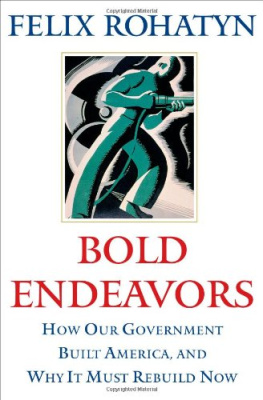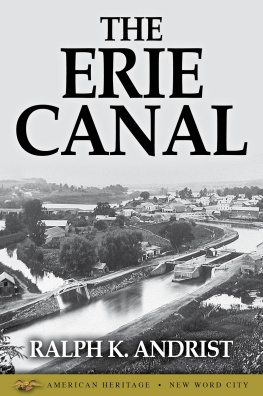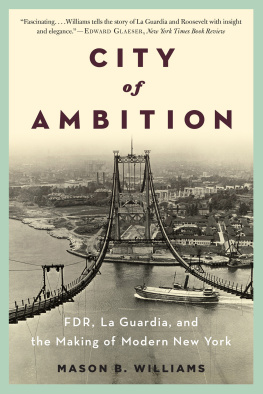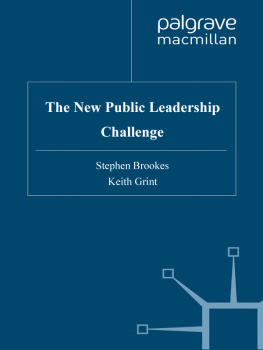Copyright 2009 by Felix G. Rohatyn
All rights reserved, including the right to reproduce this book or portions thereof in any form whatsoever. For information address Simon & Schuster Subsidiary Rights Department, 1230 Avenue of the Americas, New York, NY 10020.
SIMON & SCHUSTER and colophon are registered trademarks of Simon & Schuster, Inc.
PROLOGUE
T HE NATION IS FALLING apartliterally. Americas roads and bridges, schools and hospitals, airports and railways, ports and dams, waterlines and air-control systemsthe countrys entire infrastructureis rapidly and dangerously deteriorating.
When the levees fail to hold back the floodwaters in New Orleans or a bridge collapses during rush hour in Minneapolis, there are headlines and collective national sighs of concern. Short-term solutions are offered up. But after the sense of emergency passes, the countrys attention moves on, too. These tragedies, however, are only harbingers of the many national disasters that are to come.
Time has taken its toll on America. Consider these daunting statistics cited in a recent report to Congress: Three quarters of the countrys public school buildings are outdated and inadequate. More than a quarter of the nations bridges are obsolete or deficient. It will take $11 billion annually to replace aging drinking water facilities. Half the locks on the more than 12,000 miles of inland waterways are functionally obsolete. The American Society of Civil Engineers has estimated that over the next five years an investment of $1.6 trillion will be needed simply to make the nations infrastructure dependable and safe.
Worse, while little is being done to remedy these deficiencies, the demands on the nations beleaguered infrastructure continue to grow. Over the next decade airline passenger travel is anticipated to increase by about one third. Freight tonnage will grow by nearly one half. And the highways and roads will continue to be clogged: Americans already spend 3.5 billion hours each year in traffic.
Greater demand multiplied by increased deterioration is an equation that can only produce woeful results for the nation. Aviation delays will cost the U.S. economy an estimated $30 billion by 2015. Traffic congestion will waste untold hours, further pollute the air, and burn nearly $100 billion each year in wasted fuel. More consequentially, each year an estimated 13,000 deaths can be attributed to poor highway maintenance.
There are, of course, many other disturbing examples of decay throughout the country that could be cited in this equation. Ports, trains, schools, waste and water systemsthe nation is growing older on every front. Regardless of what is scrutinized, in the end it all adds up to the same very despairing result: The aging of our nations infrastructure has lessened our productivity, undermined our ability to compete in the global economy, shaken our perceptions about our own safety and health, and damaged the quality of American life.
What must be done?
America needs to rebuild its infrastructure. It is a critical national priority, a costly long-term investment, and a visionary enterprise. It is a program that can provide tens of millions of much needed jobs. And it is an undertaking that can only succeed if it is directed, coordinated, and largely financed by the federal government.
THIS BOOK IS AN attempt to demonstrate through ten examples from our history that the federal government has traditionally been the indispensable investor in our nation. Each of the ten chapters is a case study of how an activist government, led by bold leaders with vision and perseverance, made far-seeing investments that helped to shape America. Presidents Jefferson, Lincoln, and Franklin Roosevelt, in fact, heroically found the will in the midst of grave national crises to look beyond the turmoil of the times in which they lived to strengthen the nations future. Together, these ten historical precedents offer up a balance sheet of sorts: an accounting of the many returns, anticipated and unanticipated, material and spiritual, that the nation has reaped from propitious government investmentsdecisions which in their time were attacked as costly, unmanageable, and unnecessary. And the ten case studies that follow are not unique. The stories of other beneficial government initiatives could have been told; for example, the development of radar, the eradication of polio, the commitment to land a man on the moon.
Yet it is also important to note that while the activist principle embodied in these case studies remains valid and instructive, some of the actions initiated by the government were flawed, morally complacent, or manipulated by the marketplace. Some decisions were guided by self-interest and the consequences were detrimental. For example, while we celebrate the ingenuity that built the Panama Canal and the transcontinental railroad, at the same time we must also recognize the arrogance that led America to enforce its will on a sovereign nation and ignore the cruel conditions and dangers that immigrant Chinese rail workers had to confront. The examples cited are bold endeavors, decisions made by visionary leaders, but we must also recognize the flaws in some of these initiatives. The specifics too often are warnings, a reminder to put these achievements in perspective, and to apply moral standards to future national undertakings.
I AM NOT A historian, and this book is at its heart not a history. It is a narrative implicitly animated by the real-world experiences I had and the lessons I learned while working in a time of economic crisis with New Yorks Municipal Assistance Corporation (MAC) for eighteen years and during my tenure as an ambassador. Fundamentally, however, I have always been a banker, and this book is at its core a bankers call for action.
In opposition to the voices who choose to ignore the many successful examples from our nations past (including those recounted in these pages) to argue that government intervention in the economy is always wasteful and ill-considered, this book is an appeal that we treat the renewal of our infrastructure as a necessary federal capital investment and not as just another expense item. In the epilogue I will offer a plan for establishing a National Infrastructure Bank. It is a program for creating an entity that will finance major infrastructure improvements with public, private, and international capital. This is a bank that will help America in a time of great economic crisis to finance public projects in a way similar to the European Investment Bank, which has underwritten high-speed rail networks. It will allow the country to keep pace with China where, starting in 2006, $200 billion will be invested in railways over four years.
Ultimately, this book offers a choice. Either we learn from our history and support a program that encourages the federal government to make significant investments to improve the way we live and work; or we complacently let time continue to take its toll on a great, yet aging nation. The past, the stories, and the leaders in this book remind us, need not be simply past. We as a nation must find the courage and the will to learn from our history, and then act.













